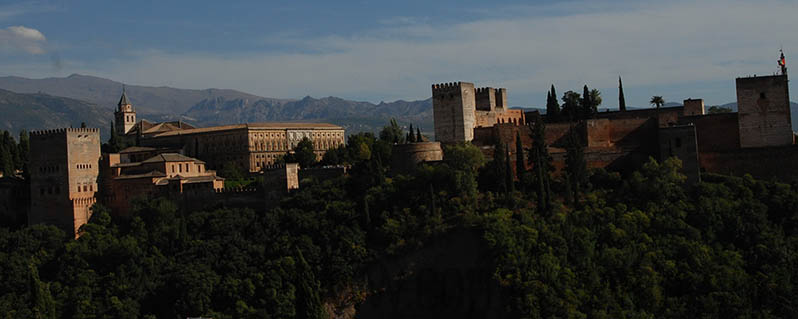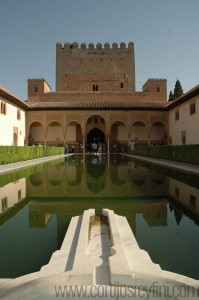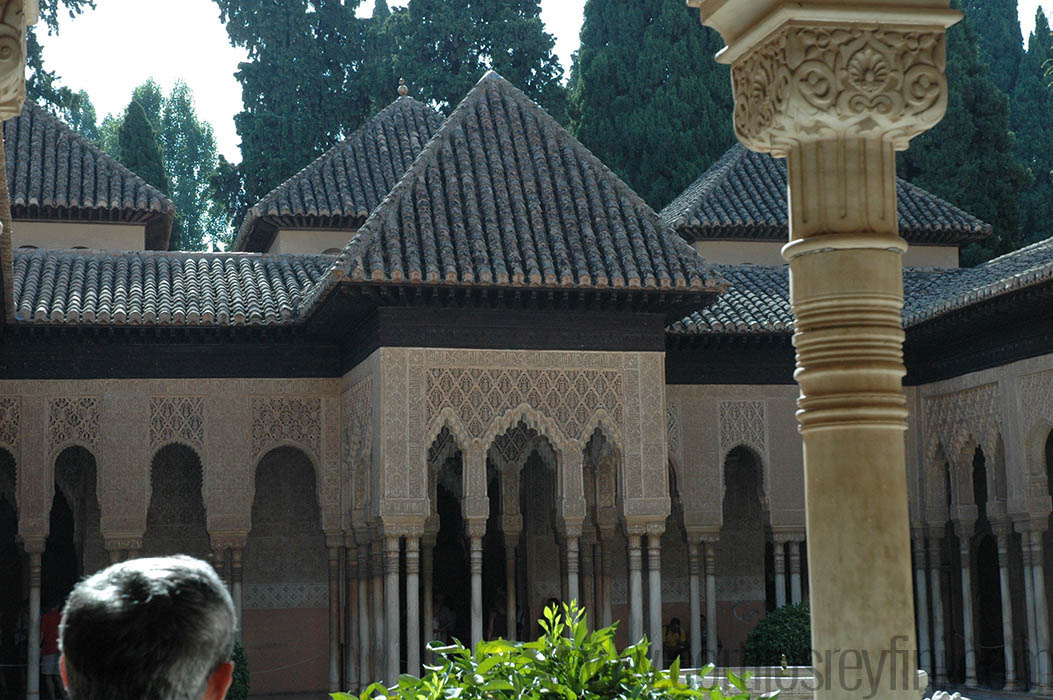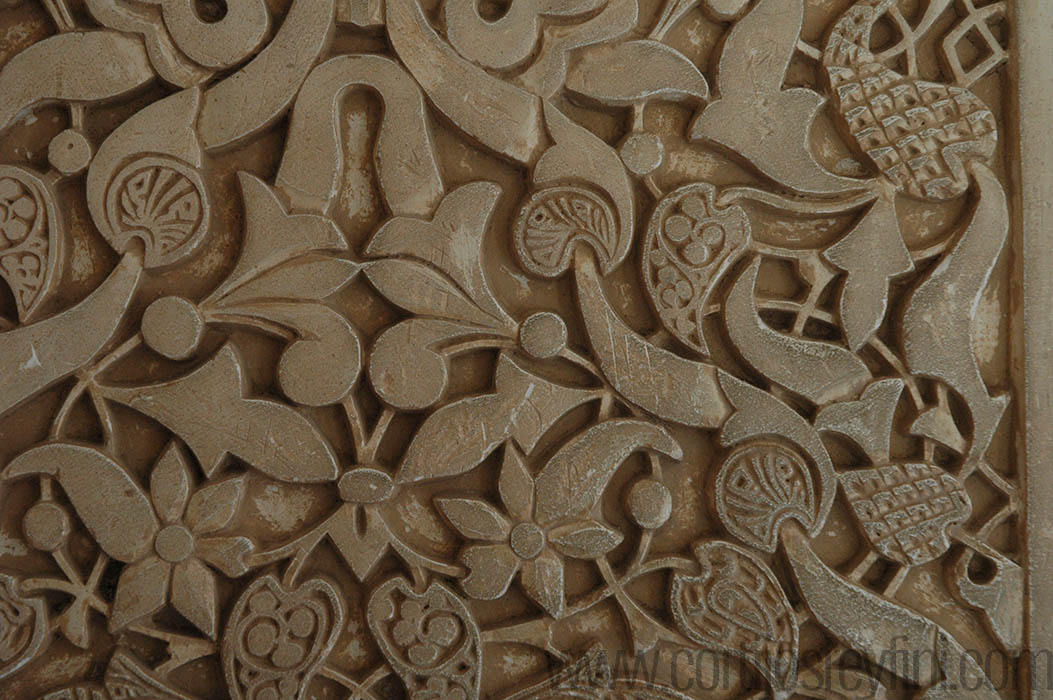
The Alhambra fortress complex is located in Granada, Andalusia, Spain. It was originally constructed as a small fortress in 889 and then largely ignored until its ruins were renovated and rebuilt in the mid 11th century by the Moorish king Mohammed ben Al-Ahmar of the Kingdom of Granada who built the current palace and walls. It was later converted into a royal palace in 1333 by Yusuf I, Sultan of Granada.

The Alhambra’s Islamic palaces were built for the last Muslim emirs in Spain and its court of the Nasrid dynasty. After the Reconquest by the Reyes Católicos (Catholic Monarchs) in 1492, some portions were used by Christian rulers. The Palace of Charles V, built by Charles V, Holy Roman Emperor in 1527, was inserted in the Alhambra within the Nasrid fortifications. After being allowed to fall into disrepair for centuries, the Alhambra was rediscovered in the 19th century by European scholars and travellers, with restorations commencing. It is now one of Spain’s major tourist attractions, exhibiting the country’s most significant and well known Islamic architecture, together with 16th-century and later Christian building and garden interventions. The Alhambra is a UNESCO World Heritage Site, and the inspiration for many songs and stories.

Moorish poets described it as “a pearl set in emeralds,” in allusion to the colour of its buildings and the woods around them. The palace complex was designed with the mountainous site in mind and many forms of technology were incorporated. The park (Alameda de la Alhambra), which is overgrown with wildflowers and grass in the spring, was planted by the Moors with roses, oranges and myrtles. Its most characteristic feature, however, is the dense wood of English elms brought by the Duke of Wellington in 1812. The park has a multitude of nightingales and is usually filled with the sound of running water from several fountains and cascades. These are supplied through a conduit 8 km (5.0 mi) long, which is connected with the river Darro at the monastery of Jesus del Valle above Granada.
Despite long neglect, wilful vandalism and some ill-judged restoration, the Alhambra endures as an atypical example of Muslim art in its final European stages, relatively uninfluenced by the direct Byzantine influences found in the Mezquita of Cordova. The majority of the palace buildings are quadrangular in plan, with all the rooms opening on to a central court; and the whole reached its present size simply by the gradual addition of new quadrangles, designed on the same principle, though varying in dimensions, and connected with each other by smaller rooms and passages. The Alhambra was extended by the different Muslim rulers who lived in the complex. However, each new section that was added followed the consistent theme of “paradise on earth”. Column arcades, fountains with running water, and reflecting pools were used to add to the aesthetic and functional complexity. In every case, the exterior was left plain and austere. Sun and wind were freely admitted. Blue, red, and a golden yellow, all somewhat faded through the passing of time and exposure, are the colours chiefly employed.

The decoration consists, as a rule, of Arabic inscriptions that are manipulated into sacred geometrical patterns wrought into arabesques. Painted tiles are largely used as panelling for the walls. The palace complex is designed in the Mudéjar style which is characteristic of western elements reinterpreted into Islamic forms and widely popular during the Reconquest of the Iberian Peninsula from the Muslims by the Christian kingdoms.
We highly recommend a visit to the Alhambra in Granada but it is extremely busy during the summer months. Please see below for help on buying tickets. If you intend to go, we recommend you try and leave the cortijo at 7 am, getting there at around 8.30. To get to Granada from our cortijos, you’ll have to drive to Orgiva, then follow the signs to Lanjaron and then to Granada. You will find the Alhambra turning clearly sign posted at the beginning of Granada.
There are plenty of car park spaces available. To view all the grounds, it takes a minimum of three hours, and then if you intend to see the old part of Granada, you can leave your car at the Alhambra car park and catch the local minibus down to the historic parts of the town, or, alternatively you can walk.(for more information about Granada please see the section under Granada) Please also visit our links page for more information about the Alhambra and Granada.
How to Buy Tickets for the Alhambra, Granada:
During July and August, you are better off to book your tickets in advance to the Alhambra. You can do this online
Prices are for booking in advance from ticket master: https://tickets.alhambra-patronato.es/en/
Or you can buy over the phone in advance:
Call +34 934 923 750.
Again, pick up your tickets from the Alhambra Ticket Office (where it says Retirada de Reservas). Bring the same credit card that you used to make the booking
You can also buy tickets there, on the gate (but not recommended during high season).
These tickets are only valid for the day of purchase of the ticket.
Tickets can be acquired in the ticket offices or in the automatic machines located in the Access Pavilion in the Alhambra.
Tickets can be sold out in advance so availability is not guaranteed.
In high season, weekend, etc, arriving earlier to the ticket office is recommended due to possible long queues.
You cannot change the date or the time of the visit once you have bought a ticket
Payment method:
Only cash at the ticket office
Only credit card at the automatic machines (In this case a management commission will be added to the ticket price)
For further information please see our blog on cortijosreyfini website.
Price Guide:
General daytime visit, (including the Alcazaba, the Nasrid Palaces, and the Generalife:
€15.40 (standard ticket), €10.40 for EU senior citizens (65+) and students, €9.40 for disabled visitors and children aged 12-15 and free entry for children under 12.
Night visit to the Palaces: €9.30 (general ticket), free entry for children under 12.
Opening Hours:
October 15th to March 14th (entrance is restricted to 6,300 people per day).
Mondays to Sundays: Open from 8.30 am. to 6.00 pm.
Night-time visits are on Fridays and Saturdays 8.00 pm. to 9.30 pm.
(This visit only includes the Nasrid Palaces).
Closed: 25th December and 1st January
March 15th to October 14th (entrance is restricted to 7,700 people per day).
Mondays to Sundays: Open from 8:30 am. to 8.00 pm.
Night-time visits are Tuesdays to Saturdays from 10.00 pm. to 11:30 pm.(This visit only includes the Nasrid Palaces).
The time of your access to the Nasrid Palaces is printed on the admission tickets. You will have no access to the palaces at another time and the tickets will not be refunded.
Special note: During the months of July and August avoid starting the tour of Alhambra after 10 am. It can get extremely hot making it especially difficult if you go with small children.